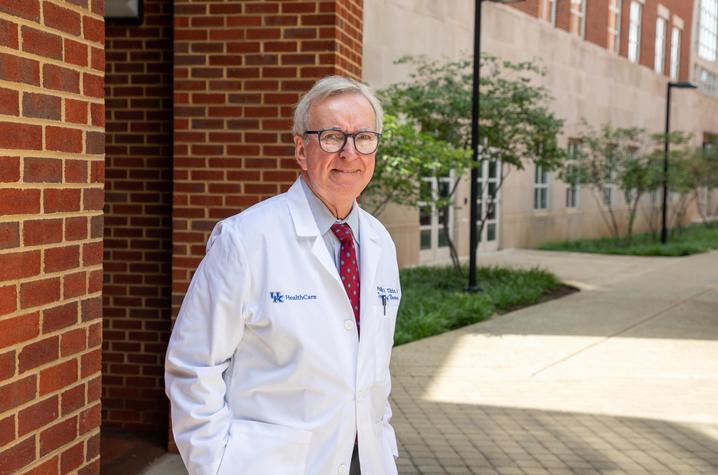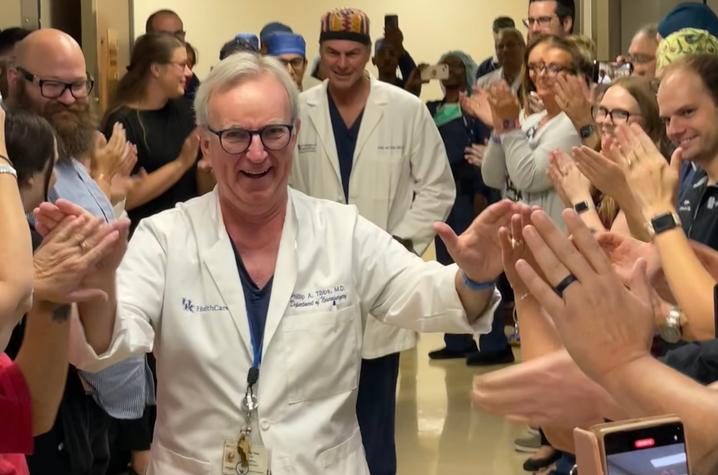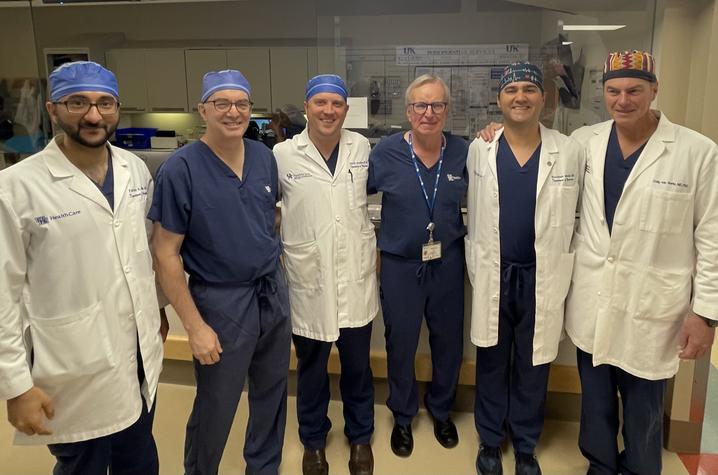'We wanted to change the world' — Phillip Tibbs’ impactful 50-year career at UK
LEXINGTON, Ky. (July 3, 2023) — “It has been said that, at its best, preservation engages the past in a conversation with the present over a mutual concern for the future,” said William Murtagh, first keeper of the National Register of Historic Places.
That is a quote Phillip Tibbs, M.D., understands as a history enthusiast with years devoted to his avocation, including spending time on the board of directors for the Blue Grass Trust for Historic Preservation.
However, it is also a quote that rings true for his 50 years as part of the University of Kentucky College of Medicine’s Department of Neurosurgery. In that time, he brought the old together with the new by training and mentoring generations of new doctors, advancing the field by establishing an internationally accepted standard of care still used today, all while performing nearly 20,000 surgeries.
Last month, Tibbs closed a chapter of his storied career completing the final of his thousands of procedures as a neurosurgeon.
*****
Phillip A. Tibbs grew up as the oldest of eight children in his family. As a pursuer of history and preservation, looking back to his beginning comes naturally and with compelling detail. Tibbs, as a proud son, explains how his father did not have the chance to finish college. Just shortly after beginning school, he volunteered and served his country in the Pacific doing reconnaissance photography over Japan and nearby islands. “When he got back from the war, he had to start working. He and my mom worked at a typewriter ribbon factory,” said Tibbs. “I was the first person in my immediate family to have a chance to go to college and graduate.”
That motivated Tibbs all through his education which was fast-tracked by graduating high school at the age of 16 and receiving a scholarship to nearby Thomas More College (now known as Thomas More University). “I agonized about going into English literature or pre-med. I decided to go with pre-med and I have my Uncle Frank to thank for that,” said Tibbs.
The 74-year-old still remembers the conversation with his Uncle Frank that would not only set his impactful career in motion but also in effect touch thousands of patients. “He said, ‘You are a good student, be a doctor.’ I remember saying that’s like telling me to go be the president of the United States or an astronaut … it is impossible,” said Tibbs. Uncle Frank responded, “No, it is possible.”
In 1973, Tibbs graduated from the University of Kentucky College of Medicine and stayed home to complete his residency in neurosurgery. The neurosurgery residency program was very much still in its infancy at UK. The program saw its first resident graduate in 1970, Tibbs entered the program in 1973, he completed his residency training in 1979 and joined the neurosurgery faculty at UK. Fast forward a few decades to 2020 — the program celebrated its 50th anniversary with a very familiar hand leading as Tibbs was finishing up his time as department chair.
“I’ve had a unique position. I’m unbelievably proud of the people that we have graduated. It has just gotten better and better,” said Tibbs. “We have become an important, dynamic and relevant part of a wonderful institution that is the University of Kentucky.”
One of the biggest changes he’s seen through the years has been the implementation of sub specialization in the field. “We have really evolved and continue evolving. Critical care services are operating at an amazing standard. We are saving lives that we could only dream of saving back when I started, and we aren’t finished. There is momentum here.”
*****
The Kenton County native never imagined he would spend more than half a century on the same campus, “What can I say? I’m from Kentucky and I just really love the people here,” said Tibbs. But there was something else that also kept him at UK … research.
“I had opportunities to leave and even had reasons to leave at times, but I had a colleague named Roy Patchell,” said Tibbs. “We were both energetic and, frankly, we wanted to change the world.” Like Tibbs, Patchell is a graduate of the UK College of Medicine and returned to UK as a neurooncologist after completing his residency and fellowship.
This would mark the start of a long-time research collaboration between the two that produced not one, but three landmark publications.
“We felt that the treatment of metastatic brain tumors and spinal cord tumors was archaic,” said Tibbs. “All of the articles and literature suggested that radiation was as good as surgical intervention, but those articles were written before MRI technology was used.”
So the two enthusiastic doctors decided to combine a bit of the old with the new. “There was this wave of new technology that encouraged us to retest this all,” said Tibbs.
Tibbs and Patchell believed the best way to do this would be through a randomized clinical trial. Patchell wrote the methodology and Tibbs conducted the surgeries. The work took about five years and in 1990 they published an article in the New England Journal of Medicine that would almost instantly change the standard of care for metastatic brain tumors. “It is very clear that if you have a single metastatic brain tumor and you are not already dying of systemic disease, removing the tumor is going to keep you going for a much longer time.” This publication is still the most cited medical literature about metastatic brain tumors today.
The duo did not slow down after this groundbreaking work, conducting another randomized clinical trial that was published in the Journal of American Medical Association (JAMA) defining the indications for whole-brain radiotherapy for metastatic brain tumors.
Tibbs and his longtime collaborator were also the principal investigators of a multi-center, National Institute of Health-funded prospective randomized trial of surgery plus radiation versus radiation therapy alone for treatment of metastatic epidural spinal cord compression. This was published to international acclaim in The Lancet in 2005. It is the number one cited article by far about the treatment of metastatic tumors in the spine.
“To help change the standard of care in two incredibly important areas of medicine in one lifetime is pretty amazing,” said Tibbs. That youthful attitude at the start of this collaboration of wanting to change the world doesn’t seem too far-fetched now.
*****
During his time at UK, Tibbs ascended through the ranks — assistant professor, associate professor, professor, and eventually neurosurgery chairman in 2008. In addition to his research, training residents and surgical procedures, Tibbs also helped develop and direct the UK Spine Center.
A monumental turn for everything that he was involved in came in 2011 with the opening of the first expansion for UK’s Albert B. Chandler Hospital. Tibbs was honored to conduct the first surgery in new operating rooms. “When that was completed, we finally had the resources, the space, the beds, … I went on a recruiting mission to bring in some of the very top neurosurgeons in the country,” said Tibbs. “Then I took a step back — part of a chair’s role is to plan for the future and I had done that.”
In 2020, Tibbs was ecstatic to see Craig van Horne, M.D., Ph.D., whom he recruited to come to UK chosen to lead the department he has devoted more than half his life to. Since then, Tibbs has continued to have an impact on the department and the field as chair emeritus but is now taking another step back.
On June 21, 2023, Tibbs conducted his final surgery. He still remembers his first and says he will always remember the last.
“I just hope that I have represented the mission of UK honorably. I have loved being a doctor. To take care of people who have the profound confidence and trust to come in and lay on our table totally unconscious and let us into their body, their brains, is something I don’t take lightly,” said Tibbs. “People put their trust in doctors and doctors must live up to that trust. It is something I’ve tried to inculcate in my residents.”
An effort to combine some of the past, his experiences and knowledge, with the present, his trainees, doing it all with a great concern for the future, the patients.
Tibbs isn’t quite done using that medical degree Uncle Frank strongly but simply encouraged him to pursue. He plans to continue seeing patients at UK HealthCare’s Kentucky Neuroscience Institute and referring any patients requiring surgery to his colleagues within the neurosurgery department that he helped bring to prominence.
While he is scaling back the use of his time and skills to healing, restoring and preserving the neurological health of patients, he is looking forward to spending more time restoring and preserving history.
Tibbs plans to get more involved with the Blue Grass Trust for Historic Preservation and other community organizations during his initial phase of retirement. He is also looking forward to more time with his wife and their family. “You kind of give up part of your youth in this field, particularly what is seven rigorous years of training in neurosurgery, I certainly felt like that when I was a kid. But I don’t regret it at all,” said Tibbs. “I have a great sense of contentment and UK has been good to me.”
As the state’s flagship, land-grant institution, the University of Kentucky exists to advance the Commonwealth. We do that by preparing the next generation of leaders — placing students at the heart of everything we do — and transforming the lives of Kentuckians through education, research and creative work, service and health care. We pride ourselves on being a catalyst for breakthroughs and a force for healing, a place where ingenuity unfolds. It's all made possible by our people — visionaries, disruptors and pioneers — who make up 200 academic programs, a $476.5 million research and development enterprise and a world-class medical center, all on one campus.







